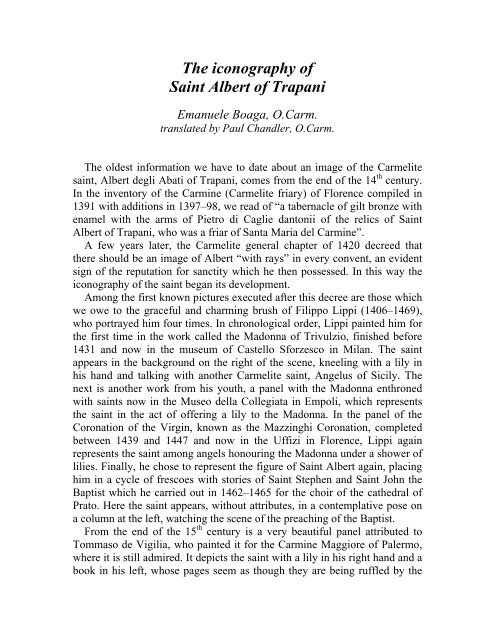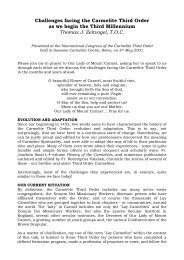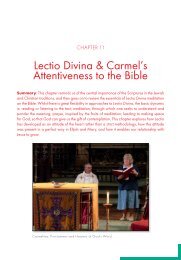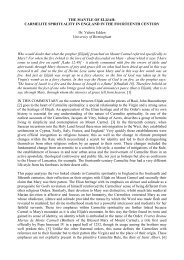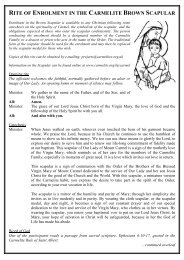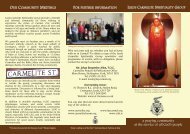Saint Albert of Trapani - British Province of Carmelite Friars
Saint Albert of Trapani - British Province of Carmelite Friars
Saint Albert of Trapani - British Province of Carmelite Friars
Create successful ePaper yourself
Turn your PDF publications into a flip-book with our unique Google optimized e-Paper software.
The iconography <strong>of</strong><br />
<strong>Saint</strong> <strong>Albert</strong> <strong>of</strong> <strong>Trapani</strong><br />
Emanuele Boaga, O.Carm.<br />
translated by Paul Chandler, O.Carm.<br />
The oldest information we have to date about an image <strong>of</strong> the <strong>Carmelite</strong><br />
saint, <strong>Albert</strong> degli Abati <strong>of</strong> <strong>Trapani</strong>, comes from the end <strong>of</strong> the 14 th century.<br />
In the inventory <strong>of</strong> the Carmine (<strong>Carmelite</strong> friary) <strong>of</strong> Florence compiled in<br />
1391 with additions in 1397–98, we read <strong>of</strong> “a tabernacle <strong>of</strong> gilt bronze with<br />
enamel with the arms <strong>of</strong> Pietro di Caglie dantonii <strong>of</strong> the relics <strong>of</strong> <strong>Saint</strong><br />
<strong>Albert</strong> <strong>of</strong> <strong>Trapani</strong>, who was a friar <strong>of</strong> Santa Maria del Carmine”.<br />
A few years later, the <strong>Carmelite</strong> general chapter <strong>of</strong> 1420 decreed that<br />
there should be an image <strong>of</strong> <strong>Albert</strong> “with rays” in every convent, an evident<br />
sign <strong>of</strong> the reputation for sanctity which he then possessed. In this way the<br />
iconography <strong>of</strong> the saint began its development.<br />
Among the first known pictures executed after this decree are those which<br />
we owe to the graceful and charming brush <strong>of</strong> Filippo Lippi (1406–1469),<br />
who portrayed him four times. In chronological order, Lippi painted him for<br />
the first time in the work called the Madonna <strong>of</strong> Trivulzio, finished before<br />
1431 and now in the museum <strong>of</strong> Castello Sforzesco in Milan. The saint<br />
appears in the background on the right <strong>of</strong> the scene, kneeling with a lily in<br />
his hand and talking with another <strong>Carmelite</strong> saint, Angelus <strong>of</strong> Sicily. The<br />
next is another work from his youth, a panel with the Madonna enthroned<br />
with saints now in the Museo della Collegiata in Empoli, which represents<br />
the saint in the act <strong>of</strong> <strong>of</strong>fering a lily to the Madonna. In the panel <strong>of</strong> the<br />
Coronation <strong>of</strong> the Virgin, known as the Mazzinghi Coronation, completed<br />
between 1439 and 1447 and now in the Uffizi in Florence, Lippi again<br />
represents the saint among angels honouring the Madonna under a shower <strong>of</strong><br />
lilies. Finally, he chose to represent the figure <strong>of</strong> <strong>Saint</strong> <strong>Albert</strong> again, placing<br />
him in a cycle <strong>of</strong> frescoes with stories <strong>of</strong> <strong>Saint</strong> Stephen and <strong>Saint</strong> John the<br />
Baptist which he carried out in 1462–1465 for the choir <strong>of</strong> the cathedral <strong>of</strong><br />
Prato. Here the saint appears, without attributes, in a contemplative pose on<br />
a column at the left, watching the scene <strong>of</strong> the preaching <strong>of</strong> the Baptist.<br />
From the end <strong>of</strong> the 15 th century is a very beautiful panel attributed to<br />
Tommaso de Vigilia, who painted it for the Carmine Maggiore <strong>of</strong> Palermo,<br />
where it is still admired. It depicts the saint with a lily in his right hand and a<br />
book in his left, whose pages seem as though they are being ruffled by the


